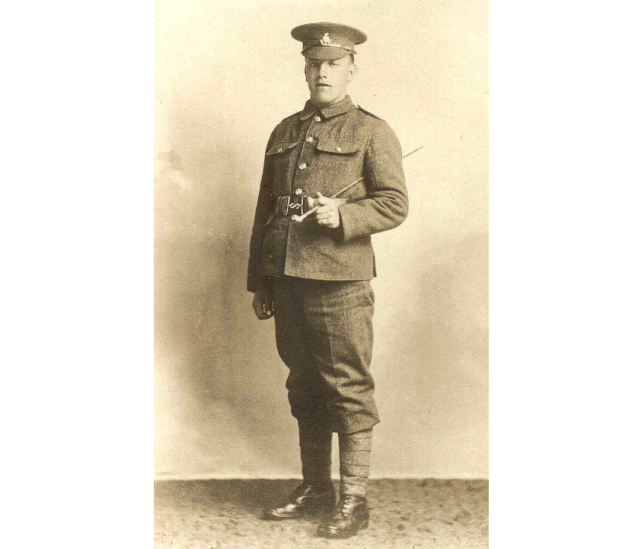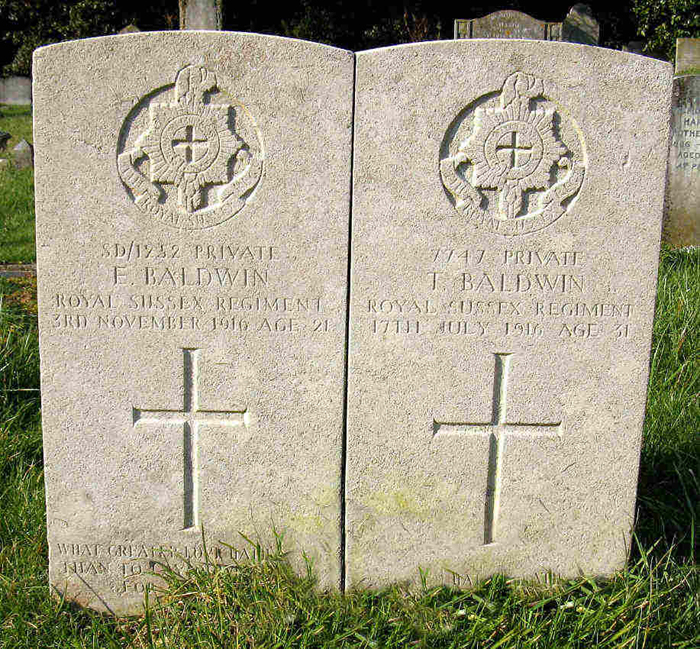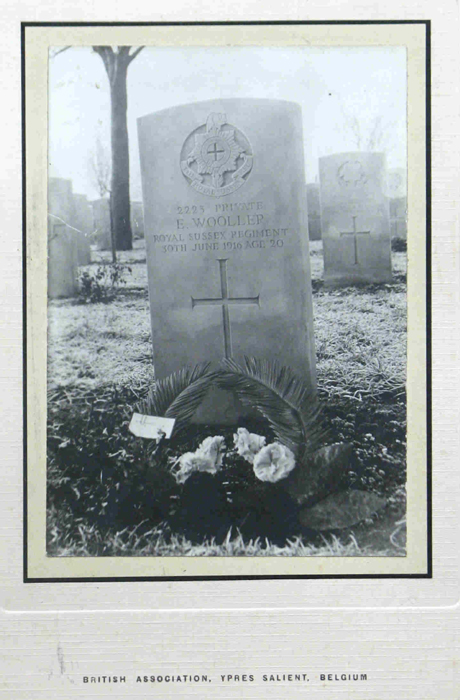My great uncle Ernest Wooller was born at Malthouse Cottages, Red Lion Street, Willingdon on 10 October 1895, the younger of two sons of David and Emily Wooller.
He enlisted in the 12th Bn. Royal Sussex Regiment at Bexhill on 17 September 1914, aged 18. His elder brother, Henry had already enlisted in the 9th Bn Royal Sussex in August. Ernest was living at 4 Rosebank Cottages, Willingdon with his parents, brother and sister. He was a carman driving horse drawn vehicles in Eastbourne and district for James Read of Lower Willingdon. After enlisting, Ernest was sent to the Cooden training camp together with his friends Edwin and Thomas Baldwin (the ‘Baldwin brothers’) who lived at 2 Lime Kiln Cottages, Willingdon where their father was foreman of the Quarry on Chalk Pit Hill. Also with Ernest was his sister’s fiancé, Albert Hendley SD/1357. All were in the 2nd Southdown Bn., the 12th Bn. Royal Sussex Regiment. The 11th, 12th and 13th battalions raised by Claude Lowther of Herstmonceux were stationed at Cooden for training, the men being known as Lowthers Lambs, their regimental mascot being a Southdown ram named Peter.
In July 1915, Ernest and his battalion moved from Cooden Mount Camp to Detling Camp at Maidstone and then, following a short time at Aldershot, the Battallions moved on to Witley Camp near Godalming. Training continued here until at 3.30am on 4 March 1916 when Ernest with his comrades in the three Southdowns Battallions marched out of camp to Milford railway station where, once on the train, an hour’s rail journey took them to Southampton Docks. There were approximately 1,000 men in each battalion and on the dock side were over 40 lorries and wagons and all the equipment and supplies needed for the men in France, plus 180 horses and 48 Lewis guns. Also waiting at the Docks was Elsie, Ernest’s 22 year old sister who had travelled from Willingdon so see her brother embark for France. There was a feeling of excitement as well as foreboding among the troops but morale was high, the men having waited some 18 months for this moment. There were many emotional scenes with relatives seeing their loved ones off. This was to be the last time Ernest and Elsie would see one another and she was also saying goodbye to Albert Hendley, her fiancé.
Two ships, the ‘Viper’ and ‘Australind’ were waiting to convey the men across the channel to Le Havre. Ernest, Albert and the Baldwin brothers, whom had been at school in Willingdon with Ernest, sailed together on ‘The Viper’ for what was a smooth uneventful crossing. The troop ships docked and the men disembarked at 7am on 5 March 1916.
From here, Ernest travelled for 22 hours by train in very cramped conditions with men and horses in goods wagons, officers in carriages, until they reached Steenbecque. A further march followed, the men arriving exhausted at Morbeque where they were billeted in schools, halls and sheds, with the officers in private houses. They had just 4 days in which to rest up before being moved on to the trenches for the first time.
Here, training continued for a planned diversionary attack at Richebourg. This was to be a two-battalion attack as a prelude to the Battle of the Somme. On the morning of Friday 30th June 1916, the assault battalions, 12th and 13th, assembled south of Rue du Bois at around 1.30am. A preparatory heavy bombardment of the enemy commenced and at just past 3 am the order was given for the assault to begin. Privates Ernest Wooller, and brothers Edwin and Thomas Baldwin, were among the men of the 12th and 13th battalions who climbed the parapet of the trenches to advance in the half light of that early morning. Ernest with the Baldwin brothers were among a group that successfully crossed No Man’s Land and reached the German front line trenches.
Others of his comrades encountered not only the fierce battery of enemy fire but uncut barbed wire. To hamper them further smoke deployed by the British disastrously drifted back across British lines causing confusion with men unable to see more than a few yards and many losing all sense of direction. They witnessed heavy casualties during their first experience of fighting. Many of their officers were killed or badly wounded, suffering horrendous injuries. Ernest and Edwin’s group was able to hold their position at first but with counter attacks increasing, they were unable to sustain this as were running out of ammunition. They kept hoping for backups but no further supplies reached them. The group by now had joined with several other men and Co. Sgt. Major Nelson Carter and with no ammunition supplies the order was given to retreat back to the British lines. Ernest was shot, fatally wounded, dying not far from the British trenches. He was 20 years old when killed. Thomas fell badly wounded. Edwin made it back fortunately surviving the heavy enemy bombardment, of the trenches, which caused numerous further casualties.
For Ernest aged 20, the war was over. He had been at the Front for just 16 weeks before he was killed at the disastrous Battle of the Boar’s Head. His school friend, Edwin, was able to tell their story to the families at home of how these Willingdon boys had fought together on that dreadful day. Thomas Baldwin was seriously wounded and taken to a field hospital. He was transported back to England on a hospital ship and died on 17 July at Eastbourne Military Hospital in what had been the medical wing of the old workhouse and later became St Mary’s Hospital. Albert Hendley missed the battle as he was hospitalized with enteric fever and was sent home for recuperation in July and August. He returned to the Front and was killed on 31 July 1917, the first day of the Battle of Passchendaele.
The Royal Sussex Regiment suffered catastrophic losses on 30 June 1916 at the Battle of the Boar’s Head, what became known as ‘The Day Sussex Died’. Many Eastbourne and Willingdon men were involved; among them Nelson Victor Carter of Eastbourne who was posthumously awarded the Victoria Cross.
Ernest, SD/2223 12th Bn. Royal Sussex Regiment 39th Division, is buried in Grave III.B.12. St Vaast Post cemetery Richebourg – l’Avoue France. The cemetery stands in an old orchard between farm buildings the site of a Trench Tramway Terminus and a Dressing Station. 850 casualties are buried here. Each year in June, the Royal Sussex Regiment Living History Group meets with the people of Richebourg for a ceremony in the cemetery to honour the memory of these young men of Sussex.
Edwin Baldwin aged 21 SD/1252 was injured in October 1916 at the Somme and was brought home and died from his wounds in Eastbourne on 3 November 1916. He is buried in the same grave with his brother Thomas 7747 aged 31 in Grave Z282 Ocklynge Cemetery Eastbourne. A third brother William Baldwin aged 23 1981 16th Bn Australian Infantry was killed at the Somme 6 August 1916 and is buried Grave X.H.11 Serre Road No 2 Cemetery.
Elsie Wooller’s fiancé Albert Thomas Hendley aged 25, was a baker and confectioner in Willingdon village and had made their wedding cake when last home on leave. He was killed a month before their planned wedding at Willingdon and is buried at Buffs Road cemetery Belgium Grave D7.
The names of Ernest Wooller, Albert Hendely, Edwin and William Baldwin are inscribed on the memorials in Willingdon parish church and Willingdon Memorial Hall together that of with Arthur White aged 25 SD/490 11th Bn Royal Sussex, also killed at The Boar’s Head. Thomas Baldwin’s name is on the Eastbourne Roll of Honour.
This story was submitted by Rosalind Hodge, Archivist, Willingdon Parish Church










